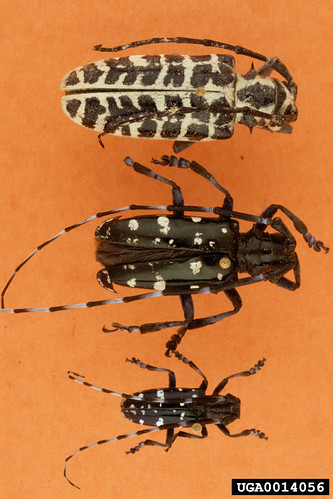Alien invaders poised to enter Arkansas, crowd out native plants, insects
Fast facts
- April is Invasive Plant Pest and Disease Awareness Month
- Visit http://www.arinvasives.org/ to learn to ID threats
(563 words)
HOPE, Ark. -- Never mind the Martians, there are plenty of earth-bound invaders poised to crowd out Arkansas native species, say experts with the Arkansas Forest Resources Center.
“Invasive pests are costly,” said Jon Barry, extension forester for the University of Arkansas System Division of Agriculture. “Invasive pests cost the U.S. economy an estimated $120 billion a year.”
Some of the more destructive and well-known invasives in the U.S. include the red imported fire ant, the Formosan termite and the zebra mussel.
Barry said it’s important for the public to know how to identify these invasive species and understand how these non-native pests spread.
“We have the http://www.arinvasives.org/ web site designed to provide information about ID and control of forest invasive pests,” he said. “We encourage people to plant native ornamental plants, or at least make sure that what they plant is not invasive.”
Arkansans are also being encouraged to “to report possible sightings of invasive pests to the Cooperative Extension Service or State Plant Board or the federal Animal and Plant Health Inspection Service, or APHIS,” said Tamara Walkingstick, associate director of the forest resources center said. “We work closely with them to investigate reported sightings and verify that it is or isn't an invasive pest.”
Arkansas is already home to many invasive species including the Bradford pear, kudzu, privet, mimosa and the northern snakehead fish.
Barry said some new invaders are poised for entry to Arkansas. Among the most serious are:
- Emerald ash borer
- Cogongrass
- Thousand-cankers disease
- Gypsy moth.
Emerald ash borer
- Emerald ash borer was found in Butler County, Mo., in the Poplar Bluff area, less
than 20 miles from the Arkansas border
- The EAB destroys 100 percent of ash trees in infested areas and ash is a significant component of the river bottom forests of eastern Arkansas.
- Emerald ash borer primarily moves by hitchhiking in raw wood products such as firewood and logs.
- The most effective means to control the spread of EAB is “Don’t Move Firewood” http://www.dontmovefirewood.org/.
- Cogongrass has been found in Washington County, Miss., in the Greenville area.
- Cogongrass invades forests and prevents growth of all other vegetation including tree seedlings.
- Cogongrass invades pastures and prevents the growth of forage grasses, but is unpalatable to cattle.
- Cogongrass spreads through seeds and rhizomes that hitchhike on mowers, automobiles, farm equipment, and logging equipment.
- The most effective means to control the spread of cogongrass is to clean automobiles and equipment before moving from infested areas, www.cogongrass.org.
- Thousand-cankers disease has been found in eastern Tennessee
- TCD, a native to the western U.S., kills most of the black walnut trees in infested areas.
- TCD is spread from tree to tree by the walnut twig beetle and probably moved east by the beetle hitchhiking in nursery stock or unprocessed walnut wood.
- The most effective means to control the spread of TCD is to buy walnut wood or nursery stock only from areas not under TCD quarantine, www.thousandcankers.com/.
The gypsy moth does not have a regular or large presence in Arkansas, but has been spotted from time to time. The gypsy moth, accidently introduced to the U.S. in the 19th century can appear in large numbers and completely defoliate oaks and aspens.
Fact sheets from the Cooperative Extension Service are available at:
- “Cogongrass: A potentially invasive weed in Arkansas,” downloadable at www.uaex.uada.edu/publications/pdf/FSA-2161.pdf
- “Emerald Ash Borer: A potential pest of ash trees in Arkansas”, downloadable at www.uaex.uada.edu/publications/pdf/FSA-7066.pdf
For more information about invasive species in Arkansas, visit http://arinvasives.org, our newly revamped site at www.uaex.uada.edu, or contact your county extension office.
Pursuant to 7 CFR § 15.3, the University of Arkansas System Division of Agriculture offers all its Extension and Research programs and services (including employment) without regard to race, color, sex, national origin, religion, age, disability, marital or veteran status, genetic information, sexual preference, pregnancy or any other legally protected status, and is an equal opportunity institution.
By Mary Hightower
The Cooperative Extension Service
U of A System Division of Agriculture
Media Contact: Mary Hightower
Dir. of Communication Services
U of A Division of Agriculture
Cooperative Extension Service
(501) 671-2126
mhightower@uada.edu
Related Links
